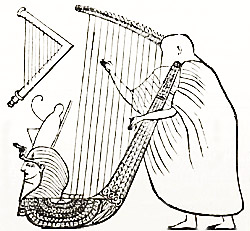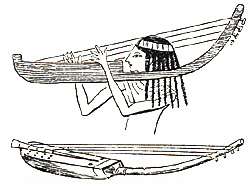
chordae obliquae

The "slanted strings" are commonly identified as an angular harp
deriving from the Near East and
Egypt, the
sambuca, described by the 2nd century CE Greek scholar Athenaeus as a four-stringed instrument invented
by the Syrians (see
Greek
stringed instruments). Oriental harps such as the sambuca, trigonum,
psalterium, and spadex produced a distinctive high piercing sound.
Similar to modern harps, these were
triangular in shape and most were played by tipping the pointed end of the
instrument to the ground. While they were known to and used by the Romans from
at least Plautus' time (see
Stichus
380-1 for the sambuca in the cargo of a Phoenician ship), they never
lost their "foreign" association (see Livy,
AUC.39.6.7;
Quintilian,
Institutio
Oratoria1.10.31).
Umbricius scornfully groups all oriental harps,
despite their differences, under the term chordas obliquas, refusing to
grace with their names the stringed instruments that flow west from the Orontes
River into the Tiber.
